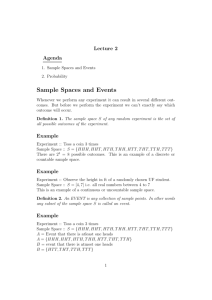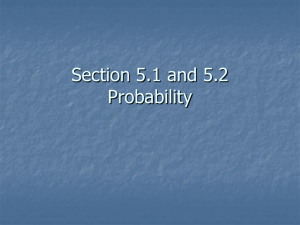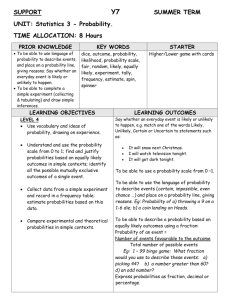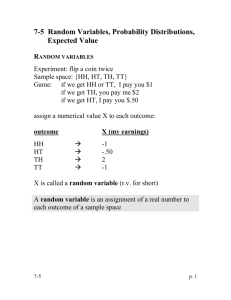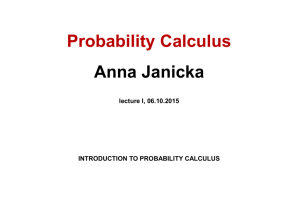Basic Probability Theory Lecture 1
advertisement
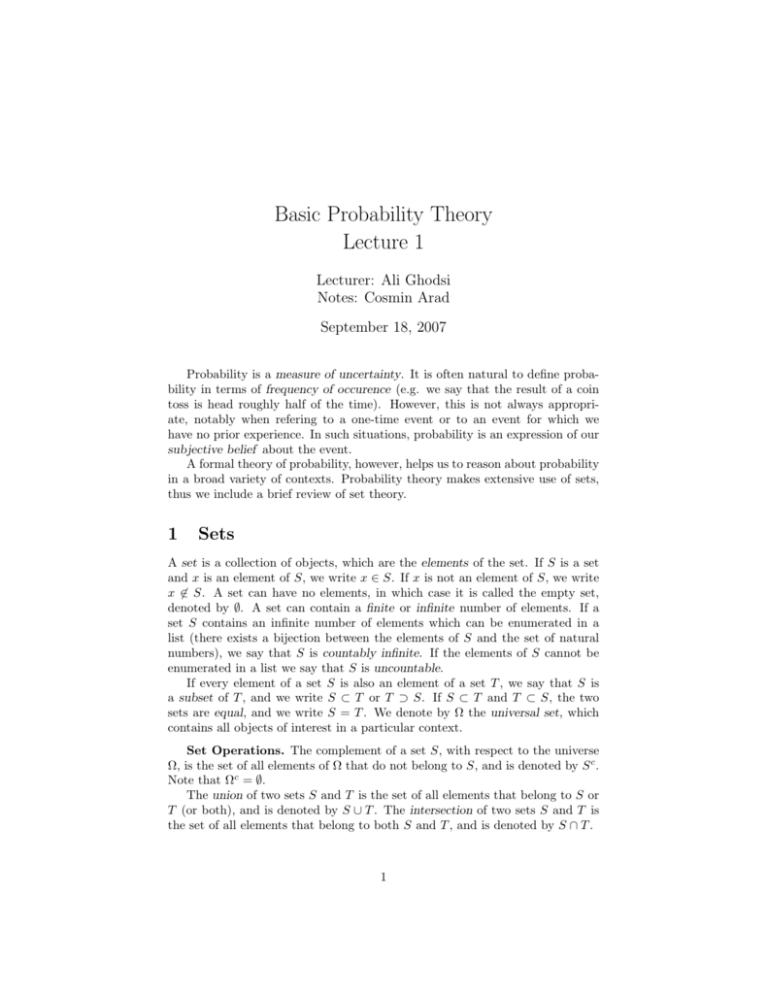
Basic Probability Theory
Lecture 1
Lecturer: Ali Ghodsi
Notes: Cosmin Arad
September 18, 2007
Probability is a measure of uncertainty. It is often natural to define probability in terms of frequency of occurence (e.g. we say that the result of a coin
toss is head roughly half of the time). However, this is not always appropriate, notably when refering to a one-time event or to an event for which we
have no prior experience. In such situations, probability is an expression of our
subjective belief about the event.
A formal theory of probability, however, helps us to reason about probability
in a broad variety of contexts. Probability theory makes extensive use of sets,
thus we include a brief review of set theory.
1
Sets
A set is a collection of objects, which are the elements of the set. If S is a set
and x is an element of S, we write x ∈ S. If x is not an element of S, we write
x 6∈ S. A set can have no elements, in which case it is called the empty set,
denoted by ∅. A set can contain a finite or infinite number of elements. If a
set S contains an infinite number of elements which can be enumerated in a
list (there exists a bijection between the elements of S and the set of natural
numbers), we say that S is countably infinite. If the elements of S cannot be
enumerated in a list we say that S is uncountable.
If every element of a set S is also an element of a set T , we say that S is
a subset of T , and we write S ⊂ T or T ⊃ S. If S ⊂ T and T ⊂ S, the two
sets are equal, and we write S = T . We denote by Ω the universal set, which
contains all objects of interest in a particular context.
Set Operations. The complement of a set S, with respect to the universe
Ω, is the set of all elements of Ω that do not belong to S, and is denoted by S c .
Note that Ωc = ∅.
The union of two sets S and T is the set of all elements that belong to S or
T (or both), and is denoted by S ∪ T . The intersection of two sets S and T is
the set of all elements that belong to both S and T , and is denoted by S ∩ T .
1
Two sets are said to be disjoint if their intersection is empty. More generally,
several sets are said to be disjoint if no two of them have a common element. A
collection of sets is said to be a partition of a set S if the sets in the collection
are disjoint and their union is S.
The Algebra of Sets. We now give some basic properties of set operations:
S ∪ T = T ∪ S, S ∩ T = T ∩ S (commutativity), S ∪ (T ∪ U ) = (S ∪ T ) ∪ U ,
S ∩ (T ∩ U ) = (S ∩ T ) ∩ U (associativity), S ∩ (T ∪ U ) = (S ∩ T ) ∪ (S ∩ U ),
S ∪(T ∩U ) = (S ∪T )∩(S ∪U ) (distributivity), (S c )c = S, S ∩S c = ∅, S ∪Ω = Ω,
S ∩ Ω = S. Two particularly useful properties are given by De Morgan’s laws
which state that
!c
!c
[
\
\
[
c
Sn
=
Sn ,
Sn
=
Snc .
n
n
n
n
Exercise: Prove De Morgan’s laws by using the definitions introduced in
this section.
The set of all subsets of a set S is said to be the power set of S and is denoted
by 2S .
2
Probabilistic Models
A probabilistic model is a mathematical model of an uncertain situation. A
probabilistic model consists of a sample space and a probability law.
Sample Spaces and Events. A sample space is the set of all possibe
outcomes of an experiment and is denoted by Ω. The outcomes of the experiment
have to be distinct, mutually exclusive (when the experiment is carried out there
is a unique outcome) and collectively exhaustive (no matter what happens in
the experiment, we always obtain an outcome that has been included in the
sample space). A subset of the sample space, that is, a collection of possible
outcomes, is called an event.
Example 1. Consider two alternative games, both involving ten successive
coin tosses:
Game 1: We receive $1 each time a head comes up.
Game 2: We receive $1 for every coin toss, up to and including the first time
a head comes up. Then, we receive $2 for every coin toss, up to the second time
a head comes up. More generally, the dollar amount per toss is doubled each
time a head comes up.
In game 1, it is only the total number of heads in the ten-toss sequence that
matters, while in game 2, the order of heads and tails is also important. Thus,
in a probabilistic model for game 1, we can work with a sample space consisting
of eleven possible outcomes, namely, 0, 1, . . . , 10. In game 2, a finer grain
description of the experiment is called for, and it is more appropriate to let the
sample space consist of every possible ten-long sequence of heads and tails.
2
Sequential Models. Many experiments have a sequential character (e.g.
tossing a coin three times). In such cases it is useful to describe the experiment
and the associated sample space as a tree-based sequential description, as in
Figure 1.
Figure 1: Two equivalent descriptions of the sample space of an experiment
involving two rolls of a 4-sided die. The possible outcomes are all the ordered
pairs of the form (i, j), where i is the result of the first roll, and j is the result
of the second. These outcomes can be arranged in a 2-dimensional grid as in
the figure on the left, or they can be described by the tree on the right, which
reflects the sequential character of the experiment. Here, each possible outcome
corresponds to a leaf of the tree and is associated with the unique path from the
root to that leaf. The shaded area on the left is the event {(1, 4), (2, 4), (3, 4),
(4, 4)} that the result of the second roll is 4. That same event can be described
by the set of leaves highlighted on the right. Note also that every node of the
tree can be identified with an event, namely, the set of all leaves downstream
from that node. For example, the node labeled by a 1 can be identified with
the event {(1, 1), (1, 2), (1, 3), (1, 4)} that the result of the first roll is 1.
Probability Laws. To complete the probabilistic model, a sample space
has to be associated a probability law, that specifies the likelihood of an event.
A probability law assigns to every event A, a number P(A), called the probability of A. Any probability law has to satisfy the following three axioms
(Kolmogorov’s axioms):
1. (Nonnegativity) P(A) ≥ 0, for every event A.
2. (Additivity) If A and B are two disjoint events (A ∩ B = ∅), then the
probability of their union satisfies
P (A ∪ B) = P (A) + P (B).
More generally, if the sample space has an infinite number of elements
and A1 ,A2 ,. . . is a sequence of disjoint events, then the probability of their
3
union satisfies
P (A1 ∪ A2 ∪ . . .) = P (A1 ) + P (A2 ) + . . .
3. (Normalization) P(Ω) = 1.
In order to visualize a probability law, consider a unit of mass which is
“spread” over the sample space. Then, P(A) is simply the total mass that was
assigned collectively to the elements of A. In terms of this analogy, the additivity
axiom becomes quite intuitive: the total mass in a sequence of disjoint events
is the sum of their individual masses.
Exercise: Prove that P (∅) = 0 and P (A1 ∪ A2 ∪ A3 ) = P (A1 ) + P (A2 ) +
P (A3 ).
Discrete Models. Consider an experiment involving a single coin toss.
There are two possible outcomes, heads (H) and tails (T ). The sample space is
Ω = {H, T }, and the events are
{H, T }, {H}, {T }, ∅.
If the coin is fair, i.e., if we believe that heads and tails are “equally likely,” we
should assign equal probabilities to the two possible outcomes and specify that
P (H) = P (T ) = 0.5. The additivity axiom implies that
P ({H, T }) = P ({H}) + P ({T }) = 1,
which is consistent with the normalization axiom. Thus, the probability law is
given by
P ({H, T }) = 1,
P ({H}) = 0.5,
P ({T }) = 0.5,
P ({∅}) = 0,
and satisfies all three axioms.
Consider another experiment involving three coin tosses. The outcome will
now be a 3-long string of heads or tails. The sample space is
Ω = {HHH, HHT, HT H, HT T, T HH, T HT, T T H, T T T }.
We assume that each possible outcome has the same probability of 1/8. Let
us construct a probability law that satisfies the three axioms. Consider, as an
example, the event
A = {exactly 2 heads occur} = {HHT, HT H, T HH}.
Using additivity, the probability of A is the sum of the probabilities of its elements:
P ({HHT, HT H, T HH}) = P ({HHT }) + P ({HT H}) + P ({T HH}
1 1 1
3
= + + = .
8 8 8
8
4
Similarly, the probability of any event is equal to 1/8 times the number of
possible outcomes contained in the event. This defines a probability law that
satisfies the three axioms.
Discrete Probability Law. If the sample space consists of a finite number
of possible outcomes, then the probability law is specified by the probabilities
of the events that consist of a single element. In particular, the probability of
any event {s1 , s2 , . . . , sn } is the sum of the probabilities of its elements:
P ({s1 , s2 , . . . , sn }) = P (s1) + P (s2) + . . . + P (sn ).
Discrete Uniform Probability Law. If the sample space consists of n
possible outcomes which are equally likely (i.e., all single-element events have
the same probability), then the probability of any event A is given by
P (A) =
number of elements of A
.
n
Example 3. Consider the experiment of rolling a pair of 4-sided dice (cf.
Fig. 2). We assume the dice are fair, and we interpret this assumption to mean
that each of the sixteen possible outcomes [pairs (i, j), with i, j = 1, 2, 3, 4],
has the same probability of 1/16. To calculate the probability of an event, we
must count the number of elements of the event and divide by 16 (the total
number of possible outcomes). Here are some event probabilities calculated in
this way:
P ({the sum of the rolls is even}) = 8/16 = 1/2
P ({the sum of the rolls is odd}) = 8/16 = 1/2
P ({the f irst roll is equal to the second}) = 4/16 = 1/4
P ({the f irst roll is larger than the second}) = 6/16 = 3/8
P ({at least one roll is equal to 4}) = 7/16.
Continuous Models. Probabilistic models with continuous sample spaces
differ from their discrete counterparts in that the probabilities of the singleelement events may not be sufficient to characterize the probability law. This is
illustrated in the following example, which also indicate how to generalize the
uniform probability law to the case of a continuous sample space.
Example 4. A wheel of fortune is continuously calibrated from 0 to 1,
so the possible outcomes of an experiment consisting of a single spin are the
numbers in the interval Ω = [0, 1]. Assuming a fair wheel, it is appropriate to
consider all outcomes equally likely, but what is the probability of the event
consisting of a single element? It cannot be positive, because then, using the
additivity axiom, it would follow that events with a sufficiently large number
of elements would have probability larger than 1. Therefore, the probability of
any event that consists of a single element must be 0.
5
Figure 2: Various events in the experiment of rolling a pair of 4-sided dice, and
their probabilities, calculated according to the discrete uniform law.
In this example, it makes sense to assign probability b − a to any subinterval
[a, b] of [0, 1], and to calculate the probability of a more complicated set by
evaluating its length. This assignment satisfies the three probability axioms
and qualifies as a legitimate probability law.
Properties of Probability Laws. Consider a probability law, and let A,
B, and C be events.
• If A ⊂ B, then P (A) ≤ P (B).
• P (A ∪ B) = P (A) + P (B) − P (A ∩ B).
• P (A ∪ B) ≤ P (A) + P (B).
• P (A ∪ B ∪ C) = P (A) + P (Ac ∩ B) + P (Ac ∩ Bc ∩ C).
3
Problems
Problem 1. Let A and B be two sets. Show that:
• Ac = (Ac ∩ B) ∪ (Ac ∩ B c )
• B c = (A ∩ B c ) ∪ (Ac ∩ B c )
• (A ∩ B)c = (Ac ∩ B) ∪ (Ac ∩ B c ) ∪ (A ∩ B c )
Problem 2.* Prove the identity
∞
A ∪ (∩∞
n=1 Bn ) = ∩n=1 (A ∪ Bn ) .
6
Problem 3 Cantor’s diagonalization argument. Show that the unit interval [0, 1) is uncountable, i.e., its elements cannot be arranged in a sequence.
Problem 4. Prove that the set of rationals Q is countable.
Problem 5. Prove that the power set of an countably infinite set is uncountable.
7
